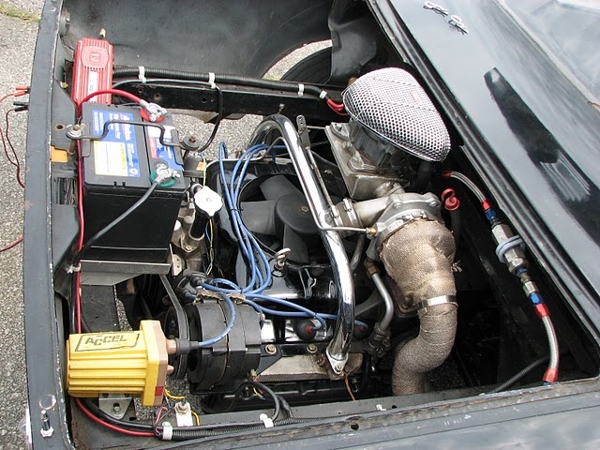
I recently read in an old issue of CORSA’s monthly magazine, The Communique, the stock weight distribution for a 1965 2-door is 37.5% on the front wheels and 62.5% on the rears (980 pounds/1630 pounds). It is generally accepted that this rear-heavy condition is not optimum for the kind of track events where high-speed turnability is desired. The writer of the Communique article went on to discuss how adding weight into the trunk helps. One-hundred-sixty pounds resulted in a 42/58 ratio and “Handling is noticeably improved in crosswinds and steering wheel returns to straight ahead with more force.” Both desirable traits for a road-course or autocross car. He goes on to state later in the article, that he “personally liked the 43/57 best for the street, but would prefer to obtain it by shifting weight from the rear to the front rather than by adding weight.” I have followed this recommendation by moving Lucy’s battery and spare tire from the engine compartment into the trunk. I estimate that I’m somewhere around the 39/61 point.
Today’s CPotD shows the engine compartment of Billy Bruce’s early model. His is an entirely different scenario. Rather than moving the battery forward, he has moved the battery rearward  as far as possible to put even more weight over the back wheels. This is because his car is built to compete in another form of racing - racing that rewards rear weight bias. Dragracers desire as much weight as possible over the rear wheels for maximum traction in a straight line. Billy’s car runs the quarter-mile in the twelves and that’s scooting.
as far as possible to put even more weight over the back wheels. This is because his car is built to compete in another form of racing - racing that rewards rear weight bias. Dragracers desire as much weight as possible over the rear wheels for maximum traction in a straight line. Billy’s car runs the quarter-mile in the twelves and that’s scooting.
 as far as possible to put even more weight over the back wheels. This is because his car is built to compete in another form of racing - racing that rewards rear weight bias. Dragracers desire as much weight as possible over the rear wheels for maximum traction in a straight line. Billy’s car runs the quarter-mile in the twelves and that’s scooting.
as far as possible to put even more weight over the back wheels. This is because his car is built to compete in another form of racing - racing that rewards rear weight bias. Dragracers desire as much weight as possible over the rear wheels for maximum traction in a straight line. Billy’s car runs the quarter-mile in the twelves and that’s scooting.
No comments:
Post a Comment